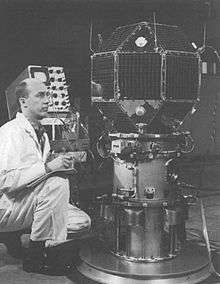Lincoln Experimental Satellite

The Lincoln Experimental Satellite series was designed and built by Lincoln Laboratory at MIT between 1965 and 1976, under USAF sponsorship, for testing devices and techniques for satellite communication.
Overview
The series had satellites named LES1 through LES9. They suffered a number of launch problems - LES1 and LES2 were supposed to be delivered to the same 2,800 x 15,000 km orbit,[1] though a failure of a boost stage left LES1 in a 2,800 km circular orbit. LES3 and LES4 were intended to be delivered to geostationary orbit, but a launch problem left them in their transfer orbit. All these satellites returned useful results despite the incorrect orbits. LES5, 6, 8 and 9 ended up successfully in geostationary orbit; the project that would have been LES7 ran out of funding and was cancelled.[2]
LES3 was a very small (16 kg) satellite containing a radio transmitter, intended to measure the extent of multi-path interference due to reflection of 300 MHz radio waves off sufficiently flat parts of the Earth.
Amongst the technologies tested on LES1 through LES4 were solid-state X-band radio equipment, low-power logic circuits, electronic despinning (using optics to determine the location of the Earth and Sun relative to a spinning satellite at any moment, and then transmitting via whichever of several antennae were best positioned with respect to the Earth), and magnetic torquers.[3]
LES8 and LES9 were satellites of around 450 kg mass, launched on March 14, 1976. They were originally planned to be equipped with pulsed plasma engines but actually launched with gas thrusters; unusually for communication satellites, they are powered by MHW-RTGs rather than by solar panels.[4] There was a cross-link between them in the 36–38 GHz part of the K band, with UHF up- and down-links; they are still operated, and the cross-link technology is used by NASA's TDRSS satellites. The original intention was to run the cross-link at a frequency in the 55–65 GHz range, which is absorbed by water, so that it would be impossible for Earth-based receivers to pick up scattered signals, but technology at the time was inadequate. They operated in geostationary orbit until 1992 and now are drifting slowly.
Lincoln Laboratory's next satellite-communication project after LES was the construction of FLTSAT EHF Packages.
LES1 radio signal recovery, 2013
In February and March 2013, amateur radio sources announced that an amateur radio satellite enthusiast, Phil Williams (G3YPQ), from North Cornwall in southwest England, had detected signals from LES-1 and determined the source after searching for identifying information on the internet. LES-1 was determined to be tumbling at about a 4-second interval (rotation speed) as determined by distinctive fading of the signals. It has been suggested that, after 46 years, the batteries have failed in a manner that allows them to carry charge directly through to the transmitter on 237 MHz, allowing it to start up when it is in sunlight.[5][6][7]
LES-1 was used as a central element in the artwork Signal Tide by artist duo Kovács/O’Doherty, which was presented at the Los Angeles County Museum of Art in September 2017.[8] The work combines composed and generative music with the live signal of the LES1, and was undertaken in collaboration with musician David Bryant.
List of LESs
- LES1, launched 1965
- LES2, launched 1965
- LES3, launched 1965
- LES4, launched 1965
- LES5, launched 1967
- LES6, launched 1968
- LES7, cancelled
- LES8, launched 1976
- LES9, launched 1976
References
- ↑ "Astronautix.com". Archived from the original on 2013-08-28.
- ↑ "Thirty Years of Space Communications Research and Development at Lincoln Laboratory".
- ↑ "The Lincoln Experimental Satellite Program (LES-1,2,3,4): A Progress Report". Proceedings of Communications Satellite Systems Conference May 2–4, 1966. American Institute of Aeronautics and Astronautics.
- ↑ "Aerospace Corporation article".
- ↑ American satellite starts transmitting after being abandoned in 1967, Phil Williams G3YPQ, Southgate Amateur Radio Club, 26 February 2013, accessed 8 March 2013.
- ↑ ANS-062 AMSAT News Service Weekly Bulletins: American satellite starts transmitting after being abandoned in 1967, AMSAT, 2 March 2013, accessed 8 March 2013.
- ↑ https://www.youtube.com/watch?v=UxqwZ42NyLw LES1 radio signal recorded in Brazil, accessed 10 May 2013.
- ↑ "Whispers from Space". LACMA Art + Technology Lab, Joel Ferree, 2017.
- NASA SP-4217 Beyond the Ionosphere (derived from William W. Ward, Franklin W. Floyd (1989), Thirty Years of Space Communications Research and Development at Lincoln Laboratory) is a detailed description of satellite communications development at Lincoln Laboratory, and was used as a reference for much of this article.
See also
- Voyager Program (also used MHW-RTGs, which operated into the 21st century)